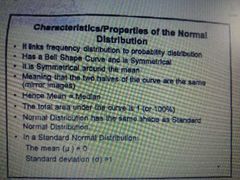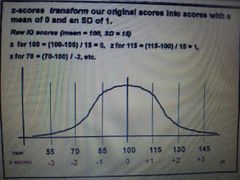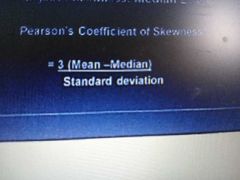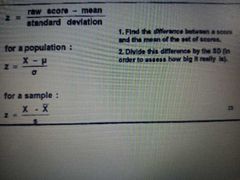![]()
![]()
![]()
Use LEFT and RIGHT arrow keys to navigate between flashcards;
Use UP and DOWN arrow keys to flip the card;
H to show hint;
A reads text to speech;
15 Cards in this Set
- Front
- Back
|
Types of Distribution |
1) Normal/Gaussian distribution 2) Frequency distribution 3) Probability distribution 4) Poisson distribution 5) Binomial distribution 6) T distribution 7) F distribution 8) Sampling distribution |
|
|
Most important distribution in Epidemiology is |
Normal/Gaussian distribution |
|
|
Normal distribution is defined by |
Mean and Standard deviation |
|
|
Normal distribution is a plot of what against what |
Frequency vs any attribute |
|
|
Relationship between normal distribution, frequency distribution and probability distribution? |
# Normal distribution links frequency and probability distribution. # Normal distribution gives frequency of an attribute (frequency) and helps predict future occurrence based on present finding (probability) |
|
|
Features of normal distribution |

|
|
|
A normal distribution has the same shape as Standard normal distribution. T/F |
True (Bell shape curve) |
|
|
In a Standard Normal distribution, what is the value of mean and standard deviation? |

# Mean is zero (point of origin) # Standard deviation is 1 (the coordinates increase from mean by multiple of SD) This is in a Standard Normal distribution. This is just for calculations and estimating Z scores. |
|
|
What is the 68-95-99.7 rule |
# It specifies the area under the bell's curve for each relationship between mean and standard deviation of distribution. # Area under curve between (M-SD) and (M+SD) is 68% # Area under curve between (M-2SD) and (M+2SD) is 95% # Area under curve between (M-3SD) and (M+3SD) is 99.7%
|
|
|
What is the mean and standard deviation of Intelligence Quotient (IQ). Apply the 68-95-99.7 rule |
# Mean IQ is 100 # Standard deviation is 15 68% of people fall between IQ of 85-115 95% fall between 70-130 99.7% fall between 55-145 |
|
|
Normal distribution is also called |
Gaussian distribution Z distribution |
|
|
Positive skewness and negative skewness, relationship between median and mean |
# Positive skewness : Mean > median # Negative skewness: Mean < median |
|
|
Pearson's coefficient of skewness |

|
|
|
Z score vs X score |
# Z scores are Standard scores (because it is computed in relation to standard deviation) # X scores are Sample scores Z score is X score minus mean divided by standard deviation. |
|
|
Z score formula |

|

